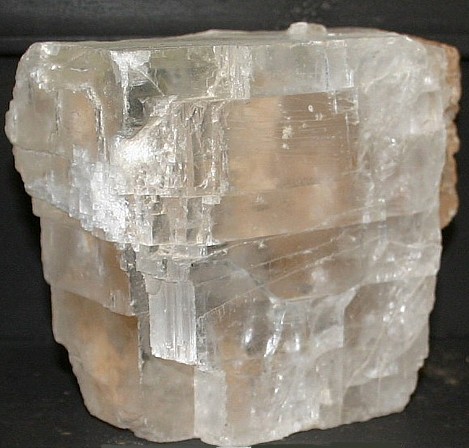|
.
Halite Mineral Facts:
Chemical Formula: NaCl - equivalent to common table salt
Colors:
Colorless to white when pure.
Halite,
when pure, is colorless, but the impurities present often color it red,
gray, yellow, purple or blue.
The bright blue mottlings observed in many specimens are thought to be
due to the presence of colloidal sodium. Its streak is
colorless or white.
Hardness:
2 to 2.5
Density:
2.17
Cleavage:
The cleavage
is
perfect parallel to each of the cubic faces.
Crystallography:
Cubic
Common
crystals in cubes, rarely octahedra; cubes often with hollow faces,
giving hopper shaped crystals. Also occurs massive and granular, rarely
in fibrous forms.
Luster:.
Luster is
vitreous. The mineral is transparent or
translucent
Optics:
(Refractive Index)
n=
1.5442
|
 |
Composition,
Structure and Associated Minerals:
A common
and widely disseminated mineral, occurring often in extensive beds and
irregular masses, interstratified in rocks of all ages, in such a manner as
to form a true rock mass. Associated with
gypsum, sylvite, anhydrite,
calcite,
clay, sand, etc. Occurs also dissolved in the waters of salt springs, salt
seas and the ocean. The deposits of salt have been formed by the gradual
evaporation and ultimate drying up of enclosed bodies of salt water. The
salt beds formed in this way have subsequently been covered by other
sedimentary deposits and gradually buried beneath the rock strata formed
from them.
Halite, or
common salt, is the best known
and most abundant of the
native chlorides. It is a colorless, transparent
mineral occurring in crystals, and in granular and compact masses. The
mineral is plastic under pressure, and its plasticity increases with the
temperature.
Identification and Diagnostics
In the closed tube halite fuses and often it decrepitates.
When
heated before the
blowpipe it fuses (at 776) and colors the flame yellow. The chlorine
reaction is easily obtained by adding a small particle of the mineral to
a microcosmic salt bead that has been saturated with copper oxide. This,
when heated before the blowpipe, colors the flame a brilliant blue. The
mineral easily dissolves in water, and its solution yields an abundant
white precipitate with silver nitrate. Salty taste. Distinguished from
sylvite (KC1) by its yellow flame color and by the latter having a
somewhat more bitter taste.
Occurrence,
Localities and Origins:
The
principal mines of halite, or rock salt, are at Wieliczka, Poland; Hall,
Tyrol; Stassfurt, Germany, where fine crystals are found; the Valley of
Cardova, Spain; in Cheshire, England and in the Punjab region of India. At
Petit Anse in Louisiana, in the vicinity of Syracuse, N. Y., and in the
lower peninsula of Michigan thick beds of the salt are buried in the rocks
far beneath the surface.
Much of the salt is
comparatively pure and needs only to be crushed to become usable. In most
cases, however, it is contaminated with clay and other substances. In these
cases it must be dissolved in water and recrystallized before it is
sufficiently pure for commercial uses. The best known deposits are at
Stassfurt where there is a great thickness of alternating layers of halite,
sylvite (KC1), anhydrite, gypsum, kieserite (MgS04 -H2O) and' various double
chlorides and sulfates of potassium and magnesium. Most of the salt produced
in the United States is obtained directly from rock salt layers by mining or
by a process of solution, in which water is forced down into the buried
deposit and then to the surface as brine, which is later evaporated by solar
or by artificial heat. In the district of Syracuse, N. Y., salt occurs in
thick lenses inter-bedded with soft shales. In eastern Michigan and in
Kansas salt is obtained from buried beds of rock salt, and in Louisiana from
great dome-like plugs covered by sand, clay and gravel.
Return to the
Mineral Collectors Information Page |
|


